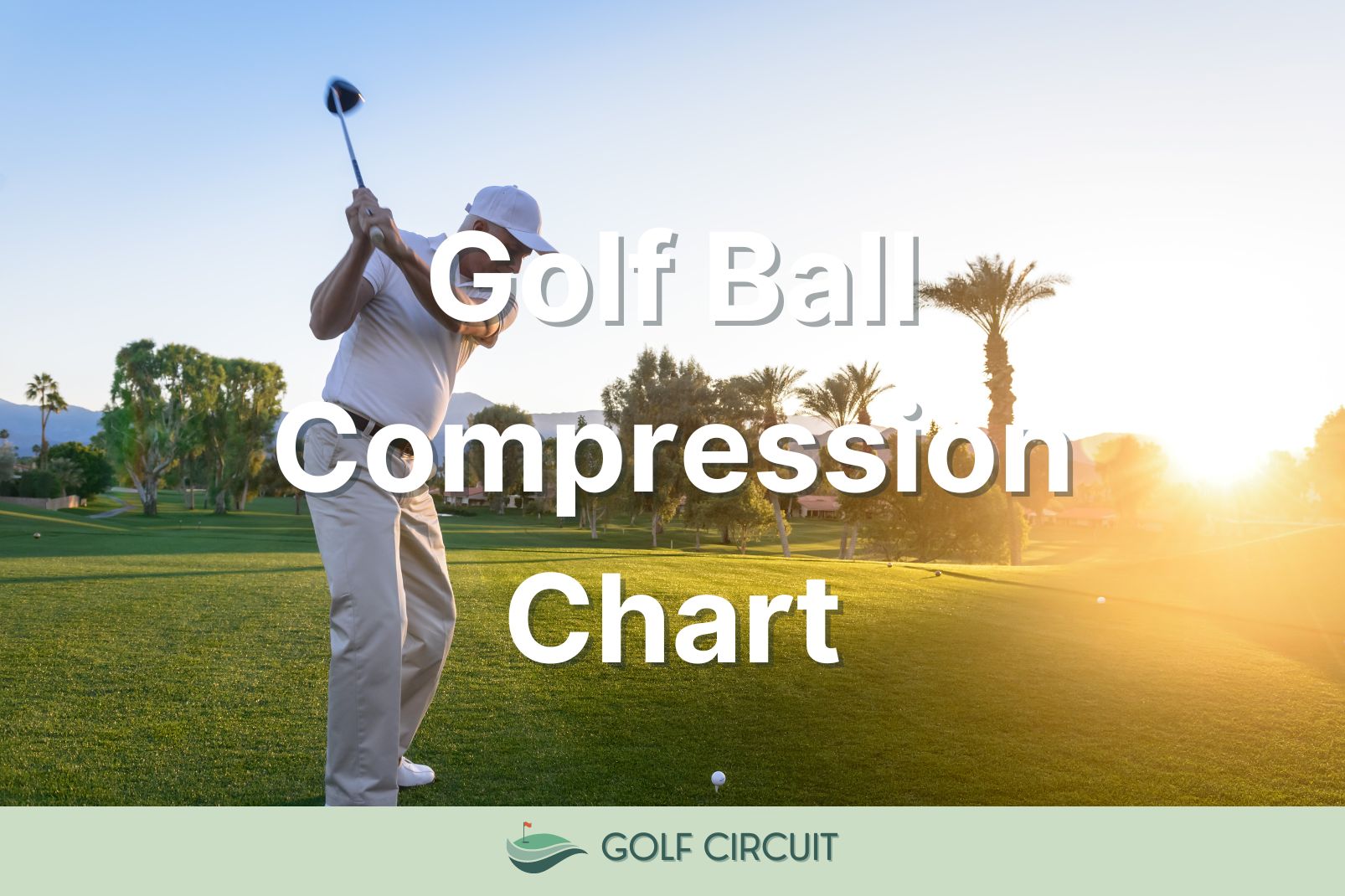Golf Ball Compression Guide (Read This Chart!)

One of the ways that golfers choose a golf ball is by looking at the compression ratings. Compression ratings vary from less than 40 to more than 120.
If you have heard one of your playing partners talk about the need for a high or low compression ball, we have all the information you need.
Understanding golf ball compression will help you make more informed decisions about the best golf ball to use on the course.
We recently did some testing of several different golf balls based on their compression, and here is what we found.
Golf Ball Compression chart
| Swing Speed | Golf Ball Compression Rating | Golf Ball Example |
|---|---|---|
| 100-105+ MPH | Very High (100+) | Mizuno RB Tour X |
| 90-100 MPH | High (85-100) | TaylorMade TP5 |
| 80-90 MPH | Medium (65-85) | TaylorMade Tour Response |
| <80 MPH | Low (Under 65) | Callaway Supersoft |
This golf ball compression chart isn’t an exact science, but it’ll give you all the information you need.
Selecting a golf ball based off your swing speed and the golf ball compression that correlates best with it is one simple way to start improving your game.
Using the chart above, you can search for golf balls that are in your compression range.
What Is Golf Ball Compression?
Golf ball compression measures how hard or soft a golf ball is. A ball with high compression is a bit harder, and it will take more for you to be able to compress the ball.
In other words, you need more strength and power to get the proper results out of a high compression ball.
With low compression, golf balls expect that you will need less swing speed or clubhead speed to get the ball to compress.
However, with having less resistance in your shots, you can expect that these lower compression balls won’t go as far for the faster swing speed player.
It would be simple if fast swing speed players could use a low compression ball and bomb it, but that is, of course, not the way that golf works.
Why Does Golf Ball Compression Matter

Golf ball compression has a big impact on the length of the shot that you can hit. Let’s face it, distance matters.
All golfers should be thinking about the golf ball they choose in terms of its impact on their game. Don’t choose golf balls simply because of the price.
There are performance factors that will greatly impact you based on the technology incorporated into the golf ball.
Distance
Low and high compression golf balls can travel a long distance. However, if you want to get the most distance out of your shots, you must use a golf ball that has a compression rating that will match your golf game.
High swing speed players that are looking for distance need to choose a high compression golf ball.
Slower swing speed players looking for distance need a low compression golf ball.
Feel
The higher the compression rating, the harder the feel of the golf ball. When you play with something that has a harder feel, expect that it’s going to impact performance on the putting green the most.
Soft feel golf balls are great, but they can sometimes get a bit too soft or even mushy feeling, and that makes it hard for players to adjust their shots.
Pricing/Ball Category
The price of golf balls will range from anywhere around $20 a dozen to more than $50 a dozen.
Although compression and pricing are not directly tied to each other, typically speaking, the higher compression golf balls are the expensive type of golf ball.
One of the things that can add to the compression rating of a golf ball is the number of layers the ball has. With three or even four layers of performance, the pricing of the golf ball increases.
When pricing goes up and compression gets higher, the result is typically a golf ball that is considered players or tour level golf ball.
Lower compression, softer golf balls are generally geared at the higher handicap players or beginners looking for more value type golf balls.
Golf Ball Compression Examples and Ranges
Now that you have a better idea as to the differences between low and high compression golf balls, it’s time to look at some real life examples.
Some golf balls will advertise their compression right on the packaging, while others will make you do your own research to find it.
Piper golf balls, for example, make it super easy to find the right golf ball compression for your swing speed.
Low Compression Golf Ball (Less than 40-65)
There are no hard set guidelines on what is considered low compression and what is considered high compression. Based on the overall options on the market, we consider anything less than 65 to be a low compression golf ball.
The lower compression balls are soft around the greens. They are typically considered distance golf balls, and most will be advertised as having a softer feel.
In addition, low compression golf balls are often very fairly priced and have branding geared at the slower swing speed players. Seniors, women, and new players are going to have plenty of low compression golf ball choices.
Low Compression Golf Ball to Try: Callaway Supersoft

In fact, it is one of the lowest compression golf balls, not just in the Callaway lineup but in any golf manufacturer’s lineup.
Callaway Supersoft golf balls are soft, they are relatively easy to compress, and they make a great option for a slower swing speed average golfer or even a new player.
With the Supersoft, you may notice that there is some trouble with getting the ball to spin around the greens. This is common with a lower compression golf ball; very few have the same high spin capabilities that you see from companies like Titleist and Bridgestone.
Overall if you are a slower swing speed golfer that wants a little more distance off the tee, the Callaway Supersoft could do the trick.
Other Low Golf Ball Compression Examples:
- Srixon Soft Feel
- Callaway Superhot
Medium Compression Golf Ball (66-85)
Medium compression golf balls are built for the medium swing speed golfer. Many of the medium compression balls are three-piece models that have some great feel and a mix of spin and distance technology.
Many of the medium compression golf balls are average-priced balls. Most players that switch to something like this will notice that there is a bit more spin and workability built into the golf ball.
Players that have slightly higher swing speeds or average swing speeds will benefit the most from the medium compression golf ball.
Medium Compression Golf Ball to Try: TaylorMade Tour Response

TaylorMade Tour Response is my favorite medium compression golf ball. The Tour Response has gone through some rigorous testing in the last few years, and it is still one of the best sellers for TaylorMade.
Essentially TaylorMade took their impressive TP5 golf ball and eliminated a few of the layers, and they came up with the Tour Response. This is like a three piece version of the high performing five piece golf ball.
What players got in return was a mix of feel and distance that makes this is a really great choice for a large majority of players.
Golfers with fast swing speeds who are playing in colder weather will find that the Tour Response helps them stay within the same general distance ranges.
In addition, slower swing speed golfers who are working on getting their speeds up a little have noticed that the TaylorMade Tour Response gives them the added spin and control boost they need.
Other Medium Golf Ball Compression Examples:
- Wilson Triad
- Titleist Velocity
High Compression Golf Ball (85+)
High compression golf balls are the player’s golf balls. These are the most difficult to compress and require the most clubhead speed in order to hit far.
Almost all golfers on professional tours are using high compression golf balls. The higher compression also means that they re getting a few extra layers of performance.
The four and five piece golf balls can allow golfers long distances off the tee while still maintaining high spin rates around the green. Don’t be surprised when you start spinning your iron and wedge shots back when using a high compression golf ball.
High Compression Golf Ball To Try

Perhaps the most well-known high compression golf ball in the game, the Titleist Pro V1 allows players plenty of extra distance and some of the best spin in golf. High spin shots make it easier to control where the ball lands and therefore improve overall accuracy.
Of course, the pricing of a Pro V1 golf ball is the downside. The Pro V1 is one of the more expensive golf balls in the game.
However, for golfers with high swing speeds that need extra compression, the pricing will be well worth it.
Other High Golf Ball Compression Examples:
- Mizuno RB Tour X
- Callaway Warbird
Frequently Asked Questions
Golf ball compression is a commonly misunderstood feature of the game of golf.
Here are some of the things you should know about the compression of your golf ball before you make your next purchase.
What is a good compression for a golf ball?
Compression is not good or bad; instead, it has to match your abilities on the golf course. A high compression golf ball, like a 90 compression ball, is best for faster swing speed players. A low compression ball around a 60 is good for slow swing speed golfers.
Do lower compression golf balls go further?
Lower compression golf balls can go further if you have a slower swing speed. Golfers with high swing speeds will not hit a lower compression golf ball very far.
What compression are Pro V1 golf balls?
The compression of the Pro V1 is between 88 and 90.
Does golf ball compression really matter?
Golf ball compression only matters in the way it impacts your performance. If a golf ball has a low compression, it does not mean its low quality; it’s simply designed for a certain type of player.
Hopefully, you have learned enough about golf ball compression to realize that it’s worth considering before you make your next golf ball purchase.
Don’t buy something that is simply cheap, as the compression may not be enough of a match for what your golf game needs. Instead, choose golf balls that fit the specific needs of your game.
Specifically, the faster you swing the golf club, the higher the compression you should be looking for. If you can’t find the compression of your current golf ball on the box, do a quick google search, and you should find something quite easily.






